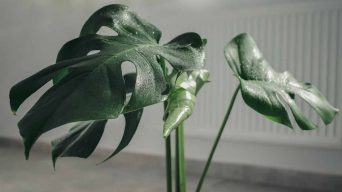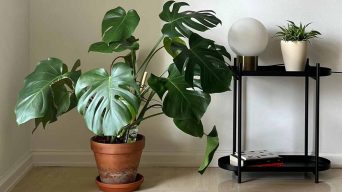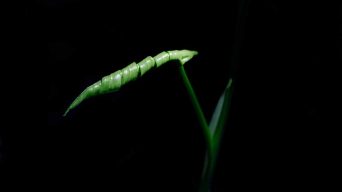Pruning is important for promoting healthy growth in monstera plants. To do it properly, wear gloves and use sharp, clean tools. Cut the leaves about two inches below the node, and sanitize your tools to avoid disease transmission. You can use clippings to propagate new plants.
Keeping a monstera plant healthy and vibrant involves more than just providing it with adequate sunlight and water.
Pruning is also an important step in caring for your monstera, as it helps to promote new growth, control the size of the plant, and maintain its shape.
Here we’ll be discussing how to prune a monstera safely and effectively so you can enjoy your beautiful plant for years to come.
We’ll cover when to prune your monstera, what tools you need, and how to use them properly.
So read on if you’re ready to learn all about pruning your beloved monstera.
Why Should You Prune Your Monstera?
If you’re a proud owner of a Monstera plant, the commonly known swiss cheese plant, you know how beautiful and impressive it can be.
However, like other plants, they require maintenance to keep them healthy and looking their best.
One essential aspect of Monstera care is pruning.
Pruning is the process of removing parts of the plant to encourage new growth and maintain its health and appearance.
Pruning your Monstera regularly can help it grow fuller, stronger, and more vibrant. It can also prevent diseases from spreading and pests from infesting your plant.
So why should you prune your Monstera plant?
First and foremost, pruning helps maintain the size of your plant. If left unpruned, Monstera plants can grow very large, which may not be ideal for indoor spaces or small gardens.
Regular pruning helps control the size of your Monstera plant while keeping it healthy.
Pruning also encourages new growth by removing dead or damaged leaves that no longer contribute to the plant’s overall health.
Cutting off these leaves allows more nutrients to go towards new growth rather than maintaining old ones.
Another reason to prune your Monstera is for aesthetic purposes.
Pruning allows you to shape your plant to suit your style and preferences.
You can create a bushier look by trimming back overcrowded areas or encourage upward growth by cutting back lower leaves.
When Should You Prune Your Monstera?
The best time to prune monstera plants is when the plant is actively growing, typically between spring and fall.
During this time, the plant has plenty of energy for new growth and can quickly recover from any pruning you do.
Avoid pruning in winter as the plant will not be able to recover as quickly and may become stressed or even die.
There are several signs that indicate the need for pruning. These include:
- Overly large plants: If your Monstera is getting too big for its space, it’s time to prune.
- Leggy growth: Leggy Monstera plants are usually a sign that the plant isn’t getting enough light. Trim back any leggy growth to encourage new, fuller growth.
- Dead or damaged leaves: Pruning off dead and damaged leaves will encourage new growth.
- Crowding: When multiple leaves are competing for the same space, it may be time to trim back a few of them.
- Long aerial roots: If your Monstera has overly long aerial roots, it’s a good idea to prune them back. This will help the plant maintain its shape and encourage new growth.
- Yellow leaves: Yellow leaves are often a sign of too much water, so it’s important to prune off any yellowing leaves that may be blocking the flow of nutrients.
- Black or brown spots: If you notice black or brown spots on your Monstera, it’s usually a sign of disease. Prune off any affected areas to prevent the disease from spreading.
- Pests: If your Monstera has become infested with pests, it’s best to prune off the affected areas immediately.
Tools for Pruning Monstera Plants
Before we dive into the actual process of pruning, it’s essential to have the right tools.
The following are some recommended tools for pruning Monstera plants:
1. Sharp and Clean Pruning Shears or Scissors
When pruning your Monstera plant, using sharp and clean pruning shears or scissors is crucial. This ensures that you make clean cuts that don’t damage the plant.
Dirty or dull tools can cause jagged cuts that can lead to infections or diseases.
Don’t forget to clean your pruning shears or scissors after each use regularly.
2. A Soft Bristled Brush
A soft-bristled brush is great for cleaning your Monstera’s leaves. This helps remove dust and dirt that can prevent the plant from absorbing sunlight properly.
It can also help remove pests such as aphids or mealybugs, which often hide in the crevices of new growth.
3. Gloves
Wearing gloves when pruning your Monstera is highly recommended.
Gloves protect your hands from the plant’s sap, which can cause skin irritation.
Use thick, protective gloves to keep your hands safe.
4. Alcohol or Bleach for Sanitizing Tools
Sanitizing your tools before and after pruning is crucial in preventing the spread of diseases between plants.
You can use alcohol or bleach to sanitize your tools.
To do this, simply dip the blades of your tools into the solution and wipe them down.
How to Prune Monstera Plants
Monstera plants are easy to prune and maintain. Here is the step-by-step process for pruning your Monstera:
- Remove Dead or Yellowing Leaves: The first step in pruning your Monstera is to remove any dead or yellowing leaves. These leaves are not only unsightly but can also attract pests and diseases that can harm your plant.
- Cut Back Overgrown Stems: If your Monstera has overgrown stems that take up too much space or block light from other parts of the plant, it’s time to cut them back. Use sharp, clean scissors or pruning shears to cut the stem just above a node (the point where a leaf attaches to the stem). This will encourage new growth from that point.
- Encourage New Growth: To encourage new growth, you can use different methods of pruning, such as topping, pinching, or cutting back. Topping involves cutting off the top part of the stem to promote branching and bushiness. Pinching involves using your fingers to pinch off the tip of a stem, which also promotes branching. Cutting back involves cutting off part of a stem to promote new growth from lower down on the stem.
- Shape Your Plant: If you want to control the size and shape of your Monstera, you can use pruning to achieve this goal. For example, if you want your Monstera to be more compact and bushy, you can use topping or pinching regularly. You can use cutting back if you want your plant to have a more vining shape.
Pruning Monstera plants is relatively easy and can help keep them healthy and looking their best.
By following the steps outlined above, you’ll be able to prune your Monstera plant with confidence in no time.
Different Methods of Pruning Monstera
Pruning Monstera plants can be done in different ways depending on your desired outcome.
Some methods of pruning include topping, pinching, and cutting back.
Topping
Topping is an effective method for promoting bushiness in your Monstera plant.
To top your plant, simply cut off the top part of the stem just above a node using sharp scissors or pruning shears.
This will encourage branching and new growth from that point.
Pinching
Pinching is a great way to promote branching and compactness in your Monstera plant.
Simply use your fingers to pinch off the tip of the stem just above the Monstera node.
To ensure healthy growth, make sure to pinch off no more than a third of the stem.
Cutting Back
Cutting back is another method used to promote new growth from lower down on the stem.
To cut back your Monstera plant, simply cut off part of a stem just above a node using sharp scissors or pruning shears.
The difference between topping and cutting back is that topping encourages new growth from the top of the stem while cutting back promotes new growth from lower down on the stem.
Tips for Shaping and Controlling Plant Size
Pruning monstera plants is an important part of plant maintenance.
Pruning helps to keep the plant healthy and promote new growth, as well as shape it for different purposes.
Here are some tips for shaping and controlling the size of your monstera plant:
- Start by snipping off any brown or yellow leaves near the base of the stem. This will help prevent disease and encourage new growth.
- Cut off any stems that are growing out of control. This will help keep the shape of your monstera neat.
- Pruning back the top portion of your monstera will reduce its size, but be careful not to cut too much, or it may stunt the plant’s growth.
- Try to prune monstera plants at least once a month. This will help keep it looking its best and encourage new growth.
- To encourage bushier growth, pinch back new shoots when they reach the desired length.
- Use string or a trellis to support and contain long vines. This will help keep your monstera looking neat and orderly.
- Use a sharp pair of scissors or pruning shears to make sure your cuts are clean and precise.
By following these tips, you can help keep your monstera looking healthy, neat, and tidy.
With regular pruning and maintenance, you can create the shape and size that best suits your space.
Aftercare for Pruned Monstera Plants
If you’ve successfully pruned your Monstera, congratulations! You’re on your way to a healthier and more beautiful plant.
But the work doesn’t end there.
To ensure that your Monstera stays healthy and continues to grow, you need to provide it with proper aftercare.
Watering
First, watering is crucial after pruning. Your Monstera will need more water than usual as it recovers from the pruning process.
However, be careful not to overwater it, as this can lead to root rot. Water your plant thoroughly but allow the soil to dry out slightly before watering again.
Fertilizing
Fertilizing is also important for post-pruning care.
Your Monstera will benefit from a balanced fertilizer that contains equal parts nitrogen, phosphorus, and potassium.
Fertilize your plant once a month during the growing season (spring and summer) and reduce fertilization in fall and winter when growth slows down.
Light
Proper lighting is essential for Monstera plants.
After pruning, ensure your plant receives bright indirect light but avoid direct sunlight as this can scorch its leaves.
A bright spot near a window with filtered light is ideal. East- or west-facing windows work well.
Temperature and Humidity
Monstera plants prefer warm temperatures (around 65-80°F) and high humidity levels.
These tropical plants thrive in high-humidity environments, so consider using a humidifier or placing a tray of water near your plant to increase moisture levels.
Regarding temperature, try to keep your Monstera plant away from drafts or extreme temperatures.
Pests and Diseases
To prevent diseases and pests, keep an eye on your Monstera’s leaves for any signs of damage or discoloration.
Remove any dead or yellowing leaves promptly, as they can attract pests and harbor diseases.
Regularly inspect your plant for common pests such as spider mites or mealybugs and treat them immediately if detected.
Final Thoughts
When it comes to pruning monstera, remember that it’s always best to err on the side of caution.
Start by removing any dead leaves or stems, then be very selective about where you make cuts.
Pay close attention to the overall shape and health of your plant and take careful note of how its new growth will affect the overall look of your monstera.
And don’t forget to use clean, sterilized tools and water the plant thoroughly after you prune it to help it heal faster.
With regular pruning and plenty of TLC, your monstera will stay healthy and vibrant for many years to come!







